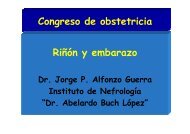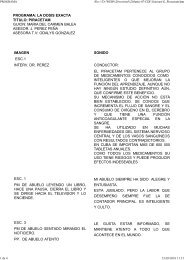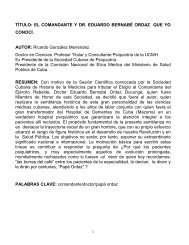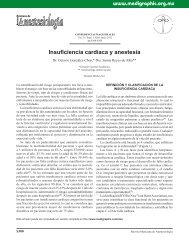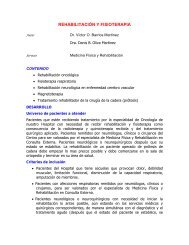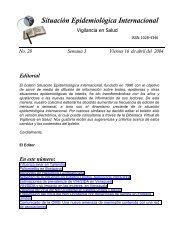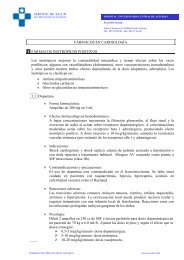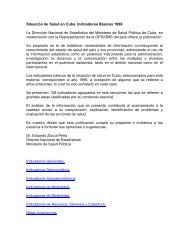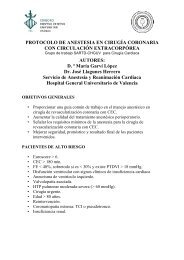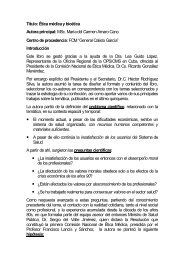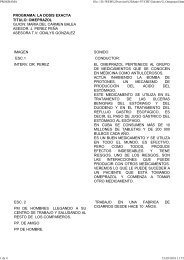Anaesthetic Management of Supratentorial Intracranial Tumours
Anaesthetic Management of Supratentorial Intracranial Tumours
Anaesthetic Management of Supratentorial Intracranial Tumours
Create successful ePaper yourself
Turn your PDF publications into a flip-book with our unique Google optimized e-Paper software.
The Indian Anaesthetists’ Forum – (www.theiaforum.org) Online ISSN 0973-0311<br />
October 2005(2)<br />
ANAESTHETIC MANAGEMENT OF<br />
SUPRATENTORIAL INTRACRANIAL TUMOURS<br />
G.S. Umamaheswara Rao<br />
Pr<strong>of</strong>essor<br />
Department <strong>of</strong> Neuroanaesthesia<br />
National Institute <strong>of</strong> Mental Health and Neurosciences<br />
Bangalore 560 029<br />
Brain tumours constitute the majority <strong>of</strong> neurosurgical conditions that<br />
present for elective operations. The nature <strong>of</strong> the lesions varies from benign<br />
tumours like meningiomas and schwannomas to highly malignant tumours like<br />
glioblatomas. About 80% <strong>of</strong> the tumors are located in the supratentorial<br />
compartment and about 20% in the posterior fossa.<br />
The anaesthetic and perioperative care <strong>of</strong> patients with brain tumours<br />
requires an understanding the following aspects:<br />
1. <strong>Intracranial</strong> pathophysiology <strong>of</strong> the tumors<br />
2. Effects <strong>of</strong> anaesthetics on brain<br />
3. Measures to decrease the brain bulk at surgery<br />
4. Intraoperative monitoring requirements<br />
5. Implications <strong>of</strong> fluid therapy<br />
6. Perioperative haemodynamic management<br />
7. Implications <strong>of</strong> surgical position<br />
8. Implications <strong>of</strong> concurrent medications<br />
PATHOPHYSIOLOGIC CONSIDERATIONS<br />
<strong>Intracranial</strong> Pressure<br />
Normal intracranial pressure (ICP) is about 10-15 mmHg. Raised ICP is a<br />
common feature <strong>of</strong> intracranial tumours. <strong>Intracranial</strong> hypertension, in these<br />
cases, results from the mass lesion itself, oedema <strong>of</strong> the surrounding brain or<br />
hydrocephalus in case <strong>of</strong> III ventricular or infratentorial tumors. Natural<br />
mechanisms such as displacement <strong>of</strong> intracranial blood volume and<br />
cerebrospinal fluid (CSF) and increased reabsorption <strong>of</strong> CSF tend to limit the<br />
increase in ICP as the tumor increases in size. When these mechanisms are<br />
exhausted, ICP increases steeply. Such steep increase in ICP leads to rapid<br />
neurological deterioration. The important consequences <strong>of</strong> raised ICP are:<br />
a) Cerebral ischemia due to reduction <strong>of</strong> cerebral perfusion pressure (CPP) and<br />
b) Brain shifts. Significant gradients <strong>of</strong> ICP within various compartments <strong>of</strong><br />
intracranial cavity lead to herniation <strong>of</strong> brain structures. The most common forms<br />
<strong>of</strong> herniation are herniation <strong>of</strong> the uncus <strong>of</strong> the temporal lobe through the hiatus<br />
in the tentorium cerebelli, herniation <strong>of</strong> the cingulate gyrus under the falx cerebri,<br />
and herniation <strong>of</strong> the cerebellar tonsils through formen magnum.<br />
Umamaheswara Rao G. S.: <strong>Anaesthetic</strong> <strong>Management</strong> <strong>of</strong> <strong>Supratentorial</strong> <strong>Intracranial</strong> <strong>Tumours</strong> 1
The Indian Anaesthetists’ Forum – (www.theiaforum.org) Online ISSN 0973-0311<br />
October 2005(2)<br />
Clinical Signs <strong>of</strong> Raised ICP<br />
Headache vomiting and papilloedema are the three cardinal signs <strong>of</strong><br />
raised ICP. Conscious patients with raised ICP complain <strong>of</strong> generalised or frontal<br />
headache. They may also have nausea and vomiting. Vomiting is generally<br />
projectile in nature. Impairment <strong>of</strong> consciousness occurs when the ICP is very<br />
high; it may vary from somnolence to stupor and deep coma. Hypertension and<br />
bradycardia represent an attempt at restoration cerebral blood flow (CBF) in the<br />
face <strong>of</strong> grossly elevated ICP. Presence <strong>of</strong> retinal haemorrhage, indicates very<br />
high ICP. A variety <strong>of</strong> abnormal breathing patterns have been observed in<br />
patients with severe increase in ICP. Periodic, irregular, deep, shallow or typical<br />
Cheyne-stokes patterns have been reported. Increase <strong>of</strong> respiratory rate is<br />
usually an initial sign <strong>of</strong> elevated ICP followed by irregularity or depression <strong>of</strong> the<br />
respiration and finally periods <strong>of</strong> apnoea and respiratory arrest.<br />
Diagnostic studies for Raised ICP<br />
Skull Radiography: Plain X-ray <strong>of</strong> the skull shows "beaten-silver" appearance and<br />
demineralisation <strong>of</strong> sella tursica in patients with chronic elevation <strong>of</strong> ICP.<br />
Angiography: Slowing <strong>of</strong> the circulation may be evident on angiography.<br />
Angiography may also show diffuse narrowing <strong>of</strong> intracerebral arteries.<br />
CT Scan: Focal or diffuse oedema is seen as hypodensity <strong>of</strong> brain parenchyma,<br />
usually in the white matter. Diffuse brain oedema is accompanied by obliteration<br />
<strong>of</strong> the basal cisterns and cerebral sulci and collapse <strong>of</strong> ventricles. Focal or<br />
perilesional oedema in cerebral hemispheres manifests with compression <strong>of</strong><br />
ipsilateral ventricle and midline shift. Significant shift <strong>of</strong> brain structures may<br />
occur without increase in the measured global ICP. Most <strong>of</strong>ten, CT scan provides<br />
a better indication <strong>of</strong> the status <strong>of</strong> ICP dynamics than direct measurement <strong>of</strong> ICP.<br />
ICP Monitoring: The indications for ICP monitoring in patients with brain tumours<br />
are not clearly defined. With easy accessibility to CT scanning, continuous ICP<br />
monitoring in patients with brain tumours has become less frequent. However,<br />
postoperative ICP monitoring may be employed in patients with massive<br />
intraoperative brain swelling requiring aggressive treatments such as mechanical<br />
ventilation, barbiturate therapy etc. ICP monitoring is also helpful in patients at<br />
enhanced risk <strong>of</strong> postoperative haematoma (e.g., intraventricular tumours).<br />
Cerebral Blood Flow Changes<br />
Normal CBF is 40-45 ml/100g/min. Cortical blood flow (70 mL/100g/min) is<br />
much higher than subcortical flow (20 ml/100g/min). In health, CBF is regulated<br />
by important mechanisms such as autoregulation and cerebral blood flowmetabolism<br />
coupling. Brain tumors may cause an increase or decrease in the<br />
CBF depending on the nature <strong>of</strong> the tumour. Changes in CBF autoregulation,<br />
vascular response to CO2 and CBF-CMR coupling also occur in these patients.<br />
Umamaheswara Rao G. S.: <strong>Anaesthetic</strong> <strong>Management</strong> <strong>of</strong> <strong>Supratentorial</strong> <strong>Intracranial</strong> <strong>Tumours</strong> 2
The Indian Anaesthetists’ Forum – (www.theiaforum.org) Online ISSN 0973-0311<br />
October 2005(2)<br />
Tolerance to arterial hypotension is reduced if the autoregulation is impaired.<br />
Loss <strong>of</strong> vascular response to CO2 may limit the usefulness <strong>of</strong> hyperventilation in<br />
decreasing the ICP. Loss <strong>of</strong> CBF-CMR coupling may result in luxury perfusion in<br />
the peritumoral zones.<br />
Implications <strong>of</strong> Cerebral Effects <strong>of</strong> <strong>Anaesthetic</strong>s<br />
<strong>Anaesthetic</strong>s may exert their effects on various facets <strong>of</strong> cerebral function<br />
such as CMRO2, CBF, cerebral blood flow-metabolism coupling, ICP,<br />
autoregulation, vascular response to CO2 and brain electrical activity. The net<br />
result <strong>of</strong> all these effects <strong>of</strong> the anaesthetic agents combined with their systemic<br />
effects may prove beneficial or detrimental to an already diseased brain.<br />
All anaesthetics, in general, decrease cerebral oxygen consumption<br />
(CMRO2) in a dose-dependent manner, but their potency varies with individual<br />
agents. Intravenous induction agents (barbiturate, prop<strong>of</strong>ol) are the most potent<br />
depressants <strong>of</strong> cerebral metabolism (CMR) followed by inhalational agents<br />
(is<strong>of</strong>lurane, sev<strong>of</strong>lurane, desflurane), benzodiazepines (midazolam) and<br />
narcotics (fantanyl, alfentanil, sufentanil). All intravenous agents with the<br />
exception <strong>of</strong> ketamine decrease ICP. All inhalational agents increase ICP, though<br />
individual agents vary in the magnitude <strong>of</strong> this effect. Intravenous agents<br />
preserve autoregulation, while inhalational agents impair it to varying degrees.<br />
Agents that cause significant impairment <strong>of</strong> autoregulation are likely to cause<br />
higher degrees <strong>of</strong> reduction <strong>of</strong> cerebral perfusion in the event <strong>of</strong> perioperative<br />
hypotension. <strong>Anaesthetic</strong> agents that produce an isoelectric<br />
electroencephalogram in clinically useful concentrations (is<strong>of</strong>lurane, sev<strong>of</strong>lurane,<br />
desflurane) are likely to play a cerebral protective role in the intraoperative period<br />
though convincing clinical evidence is lacking.<br />
Opioids have been the mainstay <strong>of</strong> neuroanaesthesia for a number <strong>of</strong><br />
years. The earlier belief that synthetic short-acting opioids agents lack any<br />
significant effect on ICP and CPP was challenged by studies that documented a<br />
small increase in CSF pressure, significant decrease in mean arterial pressure<br />
(MAP) and thus a substantial change in CPP 1 . Based on studies that reported<br />
EEG seizure activity with high doses <strong>of</strong> fentanyl in animals and humans 2,3 ,<br />
cerebral activation with corresponding increase in CBF has been proposed as<br />
the possible mechanism <strong>of</strong> this increase in ICP. A more plausible explanation<br />
came from a study in head injured patients 4 that demonstrated a close<br />
relationship between opioid-induced hypotension and an increase in ICP.<br />
Effective prevention <strong>of</strong> such hypotension prevented the increase in ICP. This<br />
observation led to the hypothesis that the ICP increase is related to the<br />
autoregulatory cerebral vasodilation in response to the hypotension caused by<br />
the opioids.<br />
Remifentanil seems to be particularly suitable for neurosurgery because <strong>of</strong><br />
its rapid onset and rapid <strong>of</strong>fset <strong>of</strong> action and minimal effect on ICP. In a human<br />
study <strong>of</strong> patients undergoing supratentorial craniotomy, remifentanil, alfentanil<br />
Umamaheswara Rao G. S.: <strong>Anaesthetic</strong> <strong>Management</strong> <strong>of</strong> <strong>Supratentorial</strong> <strong>Intracranial</strong> <strong>Tumours</strong> 3
The Indian Anaesthetists’ Forum – (www.theiaforum.org) Online ISSN 0973-0311<br />
October 2005(2)<br />
and placebo caused similar changes in ICP 5 . Most <strong>of</strong> the later studies in<br />
neurosurgical patients showed an overall efficacy and safety pr<strong>of</strong>ile that is similar<br />
to, if not better than, fentanyl. The important difference between remifentanil and<br />
other opioids is its rapid <strong>of</strong>fset <strong>of</strong> action that facilitates early response to verbal<br />
commands and rapid tracheal extubation. Patients receiving remifentanil are<br />
more likely to have immediate postoperative pain and therefore, may require a<br />
transitional analgesia 6,7 . Rapid titratability makes it a promising agent for awake<br />
craniotomy for brain tumors.<br />
During the maintenance phase <strong>of</strong> anaesthesia, rapid changes in the depth<br />
<strong>of</strong> anaesthesia can be effected with sev<strong>of</strong>lurane. Rapid emergence from<br />
sev<strong>of</strong>lurane anaesthesia facilitates early neurological examination. Smooth<br />
emergence without coughing prevents increase in cerebral venous pressure and<br />
the possibility <strong>of</strong> haematoma formation.<br />
Prop<strong>of</strong>ol <strong>of</strong>fers a number <strong>of</strong> pharmacological advantages for total<br />
intravenous anaesthesia (TIVA) in neurosurgical patients. It decreases CBF, and<br />
CMRO 2 and increases cerebrovascular resistance (CVR). Cerebral<br />
autoregulation and vascular response to carbon dioxide remain unaltered. Its<br />
effects on neuronal activity are similar to those <strong>of</strong> thiopentone. Therefore, it was<br />
proposed that, like thiopentone, it could <strong>of</strong>fer cerebral protection. The protection<br />
<strong>of</strong>fered by prop<strong>of</strong>ol seems to be a result <strong>of</strong> a decrease in CMRO2, maintenance<br />
or redistribution <strong>of</strong> CBF and prevention <strong>of</strong> large increases in blood glucose, which<br />
generally accompanies and worsens cerebral ischemia 8 . Despite these<br />
theoretical considerations, till date, there is no convincing evidence to use<br />
prop<strong>of</strong>ol as a cerebral protective agent in clinical situations.<br />
<strong>Management</strong> <strong>of</strong> Fluid and Electrolyte Balance<br />
The volume and composition <strong>of</strong> the fluid transfused have major<br />
implications in patients with cerebral pathology. While hypervolemia increases<br />
brain oedema, excessive dehydration decreases CBF.<br />
Plan <strong>of</strong> Intraoperative Fluid <strong>Management</strong><br />
Intraoperative fluid therapy in patients with brain tumors should take into<br />
account the maintenance requirements and excessive urine losses due to<br />
diuretics. Third space losses may be considered negligible in these patients.<br />
Fluid deficit due to preoperative fasting may be ignored in adult patients. The<br />
goal <strong>of</strong> intraoperative fluid management in adult patients is to achieve a mild<br />
negative balance <strong>of</strong> the order <strong>of</strong> 500-1000 mL. More meticulous calculations are<br />
required in children to ensure that there is neither a positive nor a negative<br />
balance at the end <strong>of</strong> surgery.<br />
Glucose containing solutions are preferably avoided during the first four<br />
hours <strong>of</strong> surgery. In prolonged surgeries glucose containing solutions are<br />
administered in moderation. Our own approach in this regard has been to<br />
administer alternate units <strong>of</strong> glucose-containing and non-glucose containing<br />
Umamaheswara Rao G. S.: <strong>Anaesthetic</strong> <strong>Management</strong> <strong>of</strong> <strong>Supratentorial</strong> <strong>Intracranial</strong> <strong>Tumours</strong> 4
The Indian Anaesthetists’ Forum – (www.theiaforum.org) Online ISSN 0973-0311<br />
October 2005(2)<br />
solutions for maintenance requirements. Faster infusion requirements caused by<br />
excessive diuresis or blood loss are met with by non-glucose containing<br />
solutions.<br />
Composition <strong>of</strong> the Fluid: Maintenance <strong>of</strong> mild hyperosmolality <strong>of</strong> plasma is<br />
desirable in the intraoperative period. Therefore, hypotonic fluids like 5%<br />
Dextrose in water, 1/2 N saline, 1/5 N Saline, Isolyte-M must be avoided in the<br />
intraoperative period. Isotonic solutions such as 0.9% normal saline or Ringer's<br />
lactate are the fluids <strong>of</strong> choice. Depending on the necessity (children, diabetic<br />
patients), 5% dextrose may be added to these solutions. When there is a need<br />
for large volume <strong>of</strong> fluid infusion, even Ringer's lactate is not advisable as it is<br />
mildly hypotonic with reference to plasma. While these recommendations are<br />
applicable to patients without any major preoperative electrolyte disturbances, in<br />
patients with preoperative electrolyte disturbances, the choice <strong>of</strong> the fluid is<br />
determined by the nature <strong>of</strong> disturbance involved.<br />
Mannitol: Mannitol is the commonest hypertonic solution used to provide lax<br />
brain at surgery. While causing cerebral dehydration and decreasing the ICP,<br />
mannitol has the potential to cause adverse effects such as dehydration,<br />
hyponatremia, hypokalemia, renal failure, transient increase in ICP before the<br />
diuresis sets in and exaggeration <strong>of</strong> brain shifts in patients with unilateral mass<br />
lesions. Dose recommendations for intraoperative use <strong>of</strong> mannitol vary from 0.25<br />
- 2 g/kg as a bolus. Some centres use mannitol as a routine in all cases <strong>of</strong><br />
cerebral tumors; the rationale for such practice is that mannitol, by reducing the<br />
brain bulk, provides easy access to the surgical lesion even when the ICP is not<br />
very high. In some centres mannitol is used only in situations where the brain is<br />
expected to be tense based on the preoperative CT scan. When indicated, it<br />
must be administered as a bolus over 15-20 min before opening the dura. Urine<br />
output, serum osmolality and serum electrolytes must be monitored to avoid<br />
complications related to intravascular volume and electrolyte disturbances.<br />
Implications <strong>of</strong> Surgical Position<br />
Surgery on intracranial tumours may require various positions, which<br />
include supine, prone, lateral and sitting positions. Haemodynamic and<br />
respiratory complications and nerve injuries associated with these positions need<br />
to be taken into account while positioning the patients for surgery.<br />
Sitting position has fallen to disrepute in recent years because <strong>of</strong> life<br />
threatening complications such as venous air-embolism and severe hypotension.<br />
Surgical access to the operative lesion may demand acute flexion <strong>of</strong> the neck<br />
that may cause airway obstruction and obstruction to cerebral venous outflow,<br />
resulting in intraoperative brain swelling. Elevation <strong>of</strong> the head above the heart<br />
level facilitates cerebral venous drainage; however, it may be fraught with the risk<br />
<strong>of</strong> venous air embolism from open veins if the gradient between the vein and the<br />
right atrium is sufficiently high.<br />
Umamaheswara Rao G. S.: <strong>Anaesthetic</strong> <strong>Management</strong> <strong>of</strong> <strong>Supratentorial</strong> <strong>Intracranial</strong> <strong>Tumours</strong> 5
The Indian Anaesthetists’ Forum – (www.theiaforum.org) Online ISSN 0973-0311<br />
October 2005(2)<br />
Nociceptive stimulation during the three-pin holder application must be<br />
prevented by administration <strong>of</strong> additional doses <strong>of</strong> fentanyl or infiltration <strong>of</strong> the<br />
scalp with a local anesthetic agent.<br />
Perioperative Haemodynamic <strong>Management</strong><br />
Optimal blood pressure management plays an important role in preventing<br />
major intraoperative and postoperative complications. In conditions associated<br />
with impaired autoregulation, CBF is pressure-dependent; hypotension<br />
decreases CBF and hypertension increases CBF and ICP. Intraoperatively, blood<br />
pressure must be maintained at preoperative values <strong>of</strong> the patient. Control <strong>of</strong><br />
systemic hypertension prior to surgery or control <strong>of</strong> intraoperative episodes <strong>of</strong><br />
hypertension requires consideration <strong>of</strong> the effect <strong>of</strong> such treatment on intracranial<br />
pathology and cardiovascular function. Acute normalisation <strong>of</strong> blood pressure in<br />
a patient with hypertension due to raised ICP may cause worsening <strong>of</strong><br />
neurological deficits.<br />
Induced hypotension, which was a popular technique for reduction <strong>of</strong><br />
intraoperative blood loss, is not received with same enthusiasm at present. There<br />
is substantial evidence to show that neurological morbidity <strong>of</strong> induced<br />
hypotension is significantly high while the observed benefits are marginal.<br />
Choice <strong>of</strong> antihypertensives to control hypertension - when indicated -<br />
depends on the effects <strong>of</strong> these agents on cerebral circulation and ICP. Direct<br />
vasodilators such as sodium nitroprusside, nitroglycerine and calcium<br />
antagonists are to be discouraged as they are likely to increase CBF and ICP.<br />
Beta-adrenergic blocking agents and angiotensin converting enzyme inhibitors<br />
are preferred.<br />
Implications <strong>of</strong> Concurrent Medications<br />
Anticonvulsants, and steroids are some <strong>of</strong> the common medications that<br />
these patients are likely to be receiving at the time <strong>of</strong> surgery. The patient's drug<br />
schedule should be noted so that the relevant drugs can be administered when<br />
the repeat doses are due in the intraoperative period. Drug interactions can occur<br />
between the preoperative and intraoperative medications. Anticonvulsant agent,<br />
phenytoin may decrease the duration <strong>of</strong> action <strong>of</strong> nondepolarising muscle<br />
relaxants. Adrenocortical suppression due to prolonged steroid therapy may<br />
cause unexpected hypotension intraoperatively.<br />
ANAESTHETIC MANAGEMENT<br />
Premedication<br />
In patients with raised ICP, sedative premedication carries the risk <strong>of</strong><br />
depression <strong>of</strong> consciousness, airway obstruction, hypoxia and hypercapnia and<br />
hence avoided. In patients without evidence <strong>of</strong> raised ICP, small doses <strong>of</strong><br />
benzodiazepines may be given orally on the day <strong>of</strong> surgery to allay anxiety.<br />
Narcotics may be administered after establishment <strong>of</strong> IV access, during the<br />
Umamaheswara Rao G. S.: <strong>Anaesthetic</strong> <strong>Management</strong> <strong>of</strong> <strong>Supratentorial</strong> <strong>Intracranial</strong> <strong>Tumours</strong> 6
The Indian Anaesthetists’ Forum – (www.theiaforum.org) Online ISSN 0973-0311<br />
October 2005(2)<br />
placement <strong>of</strong> monitoring devices. The patient must be carefully monitored and<br />
should not be left unattended. Other concurrent medications such as<br />
corticosteroids, anticonvulsants, antacids and medications for coincidental<br />
diseases must be continued up to the day <strong>of</strong> surgery.<br />
Intraoperative Monitoring<br />
Routine monitoring during brain tumour surgery should include ECG,<br />
invasive and noninvasive blood pressure, pulse oximetry, capnography,<br />
nasopharyngeal temperature and urine output.<br />
<strong>Anaesthetic</strong> Technique<br />
Patients who are symptomatic for raised ICP, tend to pose problems <strong>of</strong><br />
“tight brain” or “massive intraoperative brain swelling” at surgery. The majority <strong>of</strong><br />
these patients would have received steroids for sometime that might have<br />
brought the ICP under reasonable control when they present themselves for<br />
surgical intervention. Preoperative CT evidence <strong>of</strong> large tumour, excessive<br />
peritumoral oedema, gross midline shift, obliterated or effaced lateral ventricles<br />
and subarachnoid cisterns and obliterated cortical sulci suggests high ICP.<br />
Induction and intubation may aggravate intracranial hypertension. Liberal<br />
doses <strong>of</strong> thiopentone or prop<strong>of</strong>ol combined with narcotics to achieve adequate<br />
depth <strong>of</strong> anaesthesia, mild to moderate hyperventilation with mask before<br />
intubation, intravenous lignocaine bolus and avoidance <strong>of</strong> nitrous oxide and<br />
inhalational anaesthetics until such time as moderate hypocapnia is established,<br />
are some <strong>of</strong> the measures that prevent dangerous increases in ICP. Total<br />
intravenous anaesthesia may provide better operating conditions than<br />
inhalational anaesthesia; this issue however, remains controversial in the light <strong>of</strong><br />
a few studies that showed no significant difference between inhalational and<br />
intravenous anaesthesia in terms <strong>of</strong> short-term outcome measures. There are no<br />
studies on the impact <strong>of</strong> anaesthetic technique on the long-term neurological<br />
outcome <strong>of</strong> the patients.<br />
Intraoperative ICP Reduction<br />
Slack brain facilitates easy surgical access and adequate excision <strong>of</strong> the<br />
tumour. Inability to achieve adequate brain laxity is fraught with serious<br />
complications such as herniation <strong>of</strong> brain through craniotomy and excessive<br />
retractor pressure leading to retractor anaemia.<br />
Prevention <strong>of</strong> tense brain at surgery requires attention to a number <strong>of</strong><br />
details. These include smooth and unhurried induction, mild head elevation, and<br />
avoiding neck kink and pressure on the neck veins. Intubation in light planes <strong>of</strong><br />
anaesthesia must be avoided. This would require higher than normal doses <strong>of</strong><br />
induction agents, adequate muscle relaxation and administration <strong>of</strong> IV lignocaine<br />
prior to intubation. A small bolus <strong>of</strong> the IV induction agent may be repeated prior<br />
to intubation.<br />
Umamaheswara Rao G. S.: <strong>Anaesthetic</strong> <strong>Management</strong> <strong>of</strong> <strong>Supratentorial</strong> <strong>Intracranial</strong> <strong>Tumours</strong> 7
The Indian Anaesthetists’ Forum – (www.theiaforum.org) Online ISSN 0973-0311<br />
October 2005(2)<br />
Definitive measures used for decreasing the brain bulk include<br />
hyperventilation, mannitol, continuous infusion <strong>of</strong> anaesthetic agents like<br />
thiopentone or prop<strong>of</strong>ol, and CSF diversion through a ventriculostomy catheter in<br />
patients with hydrocephalus. Moderate hypothermia may be employed in<br />
extreme conditions <strong>of</strong> massive brain swelling resistant to conventional measures.<br />
Role <strong>of</strong> Hyperventilation<br />
Hyperventilation, which has been in clinical use for many years for<br />
reduction <strong>of</strong> ICP, has been subjected to more critical analysis in the recent years.<br />
Hypocapnia decreases CBF by 2-3% for each mmHg fall in PaCO2 upto 20<br />
mmHg. Normal cerebral blood volume (CBV), which is 3-4 ml/100g, is reduced<br />
by 0.049 ml/100g/mmHg change in PaCO2. If hyperventilation is sustained, CBF<br />
and CBV return to baseline over about 4 h.<br />
For many decades, it has been a practice to lower PaCO2 to improve<br />
operating conditions during craniotomy. Recently, there is some evidence to<br />
suggest that preoperative signs <strong>of</strong> raised ICP and condition <strong>of</strong> brain at<br />
craniotomy are poorly correlated and the value <strong>of</strong> routine hyperventilation to<br />
improve operating conditions remains questionable 9 . Secondly, the value <strong>of</strong><br />
hyperventilation in decreasing the brain volume seems to depend on the<br />
background anaesthetic. A recent study demonstrated diminished<br />
responsiveness <strong>of</strong> CBF and CBV to hypocapnia during prop<strong>of</strong>ol anaesthesia 10 .<br />
Benefit <strong>of</strong> hyperventilation is probably limited to reversal <strong>of</strong> inhalational<br />
anaesthetic induced cerebral vasodilation and consequent increase in CBV.<br />
Emergence from Anaesthesia<br />
Aims during emergence from anaesthesia are maintenance <strong>of</strong> stable<br />
blood pressure and ICP, thereby adequate CPP, optimal oxygenation, normal<br />
PaCO2, and normothermia. Hypertension, coughing, and asynchrony with the<br />
ventilator increase the chances <strong>of</strong> postoperative haematoma and oedema. The<br />
patient must be fully awake at the time <strong>of</strong> extubation so that neurological<br />
examination can be performed. The advantages <strong>of</strong> early versus delayed<br />
extubation are a subject <strong>of</strong> debate. The potential benefits <strong>of</strong> early awakening are<br />
feasibility <strong>of</strong> early neurological examination, and low cost. Advantages <strong>of</strong><br />
delaying the extubation by a few hours have been reported recently. The<br />
potential benefits <strong>of</strong> delaying extubation are reduced risk <strong>of</strong> hypoxemia, better<br />
respiratory and haemodynamic control, and lower incidence <strong>of</strong> postoperative<br />
haematoma formation. Obtunded consciousness and inadequate airway<br />
preoperatively, intraoperative brain swelling, problems with haemostasis during<br />
surgery, and major postoperative homeostatic disturbances warrant delaying<br />
extubation.<br />
Causes <strong>of</strong> delayed emergence: Unplanned delayed emergence is not an<br />
infrequent event after surgery for brain tumors. Some <strong>of</strong> the potential causes for<br />
such delay are seizure, intracranial haematoma, brain oedema or swelling, and<br />
tension pneumocephalus. Hypothermia, metabolic acidosis and hyponatremia<br />
Umamaheswara Rao G. S.: <strong>Anaesthetic</strong> <strong>Management</strong> <strong>of</strong> <strong>Supratentorial</strong> <strong>Intracranial</strong> <strong>Tumours</strong> 8
The Indian Anaesthetists’ Forum – (www.theiaforum.org) Online ISSN 0973-0311<br />
October 2005(2)<br />
are some <strong>of</strong> the systemic causes <strong>of</strong> delayed emergence. A CT or MRI and serum<br />
biochemistry including blood gas analysis will help the differential diagnosis.<br />
References<br />
1) Marx W, Shah N, Long C, et al: Sufentanil, alfentanil, and fentanyl: Impact on<br />
cerebrospinal fluid pressure in patients with brain tumors. J Neurosurg Anesth<br />
1989; 1:3-7<br />
2) de Castro J, Van de Water A, Wouters L, et al: Comparative study <strong>of</strong><br />
cardiovascular neurological, and metabolic side effects <strong>of</strong> eight narcotics in<br />
dogs. Acta Anaesthesiol Belg 1979; 30:5-99<br />
3) Tempelh<strong>of</strong>f R, Modica PA, Bernardo KL, et al: Fentanyl-induced<br />
electrocorticographic seizures in patients with complex partial epilepsy. J<br />
Neurosurg 1992; 77:201-8<br />
4) Werner C, Kochs E, Bause H, et al: Effects <strong>of</strong> sufentanil on cerebral<br />
hemodynamics and intracranial pressure in patients with brain injury.<br />
Anesthesiology 1995; 83:721-6<br />
5) Egan T, Minto C, Hermann D, et al: Remifentanil versus alfentanil:<br />
Comparative pharmacokinetics and pharmacodynamics in healthy adult male<br />
volunteers. Anesth Analg 1996; 82:821-33<br />
6) Balakrishnan G, Raudzens P, Samra SK, et al: Safety and efficacy <strong>of</strong><br />
remifentanil versus fentanyl in patients undergoing surgery for intracranial<br />
mass lesions. Anesth Analg 2000; 91:163-9<br />
7) Crawford MW, Leman J, Saldivia V, Carmichael FJ, Hemodynamic and organ<br />
blood flow responses to halothane and sev<strong>of</strong>lurane anaesthesia during<br />
spontaneous ventilation. Anesth Analg 1992; 75:1000-6.<br />
8) Milde LN. Brain protection . In Cucchiara RF, Michenfelder JD (Eds) : Clinical<br />
neuroanaesthesia : New York, 1990, Churchill – Livingstone, pp:188<br />
9) Cenic A, Craen RA, Howard-Lech VL, et al: Cerebral blood volume and blood<br />
flow at varying arterial carbon dioxide tension levels in rabbits during prop<strong>of</strong>ol<br />
anesthesia. Anesth Analg 2000; 90:1376-83.<br />
10) Turner CR, Losasso TJ, Muzzi DA, et al: Brain relaxation and cerebrospinal<br />
fluid pressure during craniotomy for resection <strong>of</strong> supratentorial mass lesions.<br />
J Neurosurg Anesthesiol 1996;8:126-32.<br />
Umamaheswara Rao G. S.: <strong>Anaesthetic</strong> <strong>Management</strong> <strong>of</strong> <strong>Supratentorial</strong> <strong>Intracranial</strong> <strong>Tumours</strong> 9



